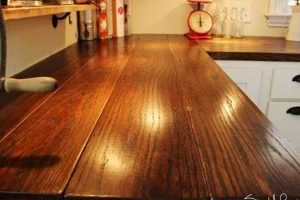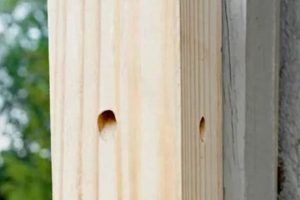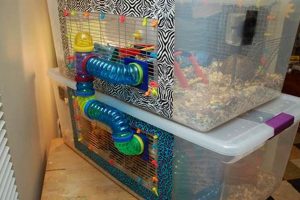A do-it-yourself modular lightweight load-carrying equipment (MOLLLE) panel involves the self-creation of a grid-like structure designed for attaching pouches, tools, and other gear. These panels offer a customizable organizational system, typically constructed from materials such as nylon webbing and a rigid backing. An example application includes mounting such a panel inside a vehicle to secure emergency equipment or attaching one to a backpack to increase external carrying capacity.
The significance of constructing one’s own attachment platform lies in the ability to tailor it to specific needs and dimensions that pre-made options may not satisfy. Benefits include potential cost savings, the freedom to select desired materials for durability and aesthetic preferences, and the satisfaction of creating a functional and personalized solution. Historically, modular attachment systems emerged from military applications before finding wider adoption in civilian contexts such as outdoor recreation and emergency preparedness.
Understanding the underlying structure, material selection criteria, fabrication techniques, and potential applications are crucial for successfully creating a custom, functional, and durable gear organization system. Further discussion will delve into these key aspects, providing practical guidance for conceptualization, construction, and deployment of a personalized attachment platform.
Considerations for Constructing a Personalized Attachment Platform
The following guidelines aim to provide essential considerations for crafting a durable and effective modular lightweight load-carrying equipment (MOLLLE) panel.
Tip 1: Material Selection: Employ high-tenacity nylon webbing for optimal strength and abrasion resistance. The backing material should exhibit rigidity and puncture resistance. Common choices include reinforced plastic sheets or sturdy canvas layered with a reinforcing agent.
Tip 2: Webbing Placement: Precisely measure and mark webbing positions to ensure consistent spacing and alignment. Inconsistent webbing placement can compromise the functionality of the modular attachment system.
Tip 3: Stitching Reinforcement: Reinforce all webbing attachment points with bar tack stitches or box stitches. These techniques provide superior strength compared to standard straight stitches, mitigating the risk of seam failure under load.
Tip 4: Edge Finishing: Implement a finished edge along the perimeter to prevent fraying and improve durability. Options include binding with nylon tape or heat-sealing synthetic materials.
Tip 5: Mounting Options: Integrate appropriate mounting hardware based on the intended application. This may involve incorporating grommets, straps, or hook-and-loop fasteners for secure attachment to surfaces.
Tip 6: Load Testing: Subject the completed panel to a load test to verify its structural integrity. Gradually increase the weight applied to the panel, observing for any signs of stress or deformation.
Tip 7: Environmental Considerations: Select materials that are resistant to environmental factors such as UV exposure and moisture. This will enhance the longevity and performance of the panel in outdoor applications.
By adhering to these guidelines, creators can enhance the durability, functionality, and longevity of a self-made modular attachment platform. Careful consideration of material selection, construction techniques, and intended applications are critical to success.
These considerations provide a foundation for the subsequent phases, including design customization and specialized applications.
1. Material Durability
Material durability is paramount in the context of do-it-yourself modular lightweight load-carrying equipment (MOLLLE) panels. The lifespan and functionality of a self-constructed panel hinge directly on the selected materials’ ability to withstand stress, abrasion, and environmental factors.
- Tensile Strength of Webbing
The tensile strength of the nylon webbing dictates the maximum load the panel can bear before structural failure. High-tenacity nylon offers superior resistance to tearing and stretching compared to standard nylon. For example, a panel constructed with webbing rated for 1000 lbs will significantly outperform one made with 500 lbs webbing under heavy load conditions, reducing the risk of equipment detachment and potential injury.
- Abrasion Resistance of Fabric
The backing fabric’s abrasion resistance determines its ability to withstand friction against other surfaces. Cordura nylon, known for its robust weave, provides enhanced protection against wear and tear compared to lighter-weight materials. Panels exposed to frequent use and harsh environments, such as those in vehicles or attached to backpacks, require materials with high abrasion resistance to prevent premature degradation and maintain structural integrity.
- UV Resistance of Components
Ultraviolet (UV) radiation from sunlight degrades many synthetic materials over time, causing them to weaken and become brittle. Selecting UV-resistant nylon and thread is crucial for panels intended for outdoor use. For instance, untreated nylon webbing can lose a significant portion of its tensile strength after prolonged sun exposure, while UV-resistant variants retain their integrity for a longer duration, extending the panel’s lifespan.
- Water Resistance/Waterproofness
The materials’ ability to resist or repel water influences the panel’s performance in wet conditions. While fully waterproof materials may not always be necessary, water-resistant coatings or fabrics can prevent moisture absorption, which can weaken the material and promote mold growth. A water-resistant panel will better protect attached equipment from rain and moisture damage, making it suitable for outdoor applications.
The interplay of these material properties directly impacts the long-term utility of a do-it-yourself modular attachment platform. The selection of appropriate materials, balanced against cost considerations, is a critical step in ensuring a durable and functional end product. Without prioritizing material durability, any perceived cost savings during the construction phase may be negated by the need for frequent repairs or replacements.
2. Webbing Configuration
Webbing configuration, referring to the strategic arrangement of webbing on a do-it-yourself modular lightweight load-carrying equipment (MOLLLE) panel, directly determines its functionality and compatibility. The spacing, orientation, and type of webbing used dictate the types and sizes of pouches or accessories that can be securely attached. Incorrect spacing renders standard pouches incompatible, limiting the panel’s utility. For instance, if horizontal webbing rows are placed
closer than the standard one inch, standard MOLLE pouches cannot interweave correctly, negating the purpose of the system. Similarly, vertical columns too far apart create insecure attachments, leading to instability and potential loss of gear. Therefore, adherence to established spacing guidelines is crucial for interoperability.
The orientation of webbing whether horizontal, vertical, or a combination influences the panel’s load-bearing capacity and the types of items that can be carried. Horizontal webbing primarily supports wider, flatter items, while vertical webbing provides a more secure anchor point for taller, narrower objects. Military rucksacks, for example, often utilize a grid pattern of both horizontal and vertical webbing to accommodate a wide range of gear, from ammunition pouches to hydration carriers. In contrast, a minimalist panel designed for a handgun holster might prioritize vertically oriented webbing for secure firearm retention. Careful consideration of intended use dictates the optimal webbing orientation for a given application.
In summary, webbing configuration is not merely an aesthetic design choice but a functional determinant of a self-made modular attachment platform. Deviation from standardized spacing or inappropriate webbing orientation introduces incompatibility and compromises the panel’s performance. Accurate planning and execution are essential to realizing the full potential of a do-it-yourself modular system. Challenges may arise in maintaining consistent spacing during construction, requiring careful measurement and precise stitching. However, mastering these techniques allows for the creation of highly personalized and effective load-bearing solutions.
3. Stitching Strength
Stitching strength directly impacts the operational reliability of a do-it-yourself modular lightweight load-carrying equipment (MOLLLE) panel. The integrity of the stitching dictates the panel’s ability to withstand stress and secure attached equipment. Insufficient stitching leads to seam failure under load, potentially resulting in the loss of gear or compromising safety. For example, a panel used to secure a medical kit inside a vehicle relies on robust stitching to prevent the kit from detaching during sudden stops or impacts. Similarly, panels used by hikers to carry water bottles or tools depend on strong seams to endure the repeated strain of movement and environmental factors. Therefore, the correlation between stitching strength and the panel’s intended use is a fundamental consideration.
Various stitch types and thread materials contribute to overall stitching strength. Bar tack stitches and box stitches, for instance, offer superior reinforcement compared to simple straight stitches. These techniques distribute stress across a wider area, mitigating the risk of concentrated stress points that can lead to seam failure. The choice of thread, such as bonded nylon or polyester, further impacts durability. Bonded nylon, known for its high tensile strength and abrasion resistance, is frequently used in heavy-duty applications. The use of incorrect thread type, such as cotton, would cause rapid failure in this context, because cotton is prone to degradation.
In conclusion, stitching strength is not a peripheral consideration but an integral component of a functional and dependable do-it-yourself modular attachment platform. Compromising on stitching quality to save time or cost introduces unacceptable risks. Understanding the principles of seam construction, selecting appropriate materials, and implementing robust stitching techniques are crucial for creating a panel capable of withstanding demanding conditions and ensuring the secure carriage of essential equipment.
4. Mounting Versatility
Mounting versatility is a critical attribute of a do-it-yourself modular lightweight load-carrying equipment (MOLLLE) panel, dictating its adaptability to various platforms and scenarios. The capacity to securely attach a panel to different surfaces significantly expands its practical applications. A limited mounting system restricts utility, while a versatile system provides broader integration options.
- Grommet Placement and Reinforcement
The strategic placement and reinforcement of grommets allow for the attachment of the panel via straps, cords, or bolts. Reinforced grommets prevent tear-out under stress, ensuring a secure and long-lasting connection. For instance, a panel with strategically placed grommets can be easily secured inside a vehicle using bungee cords or permanently mounted to a wall using bolts, providing flexible organizational solutions. Panels lacking reinforced grommets are susceptible to detachment, particularly under heavy loads or during movement.
- Hook-and-Loop Compatibility
Integrating hook-and-loop fastener sections enables quick attachment and detachment of the panel to compatible surfaces, such as backpacks or interior walls of tactical bags. This system provides a secure yet easily adjustable mounting solution. A panel with a hook-and-loop backing can be rapidly affixed to a backpack for increased carrying capacity or removed for streamlined mobility. The quality and surface area of the hook-and-loop interface directly impact the strength of the connection.
- Strap and Buckle Integration
Incorporating adjustable straps and buckles facilitates attachment to tubular structures or irregular surfaces. This system allows the panel to be secured to roll bars in vehicles, tree limbs during outdoor activities, or even to the user’s body as part of a load-bearing harness. The strength and adjustability of the straps are crucial for accommodating various diameters and shapes. Panels lacking robust straps and buckles are limited to flat, easily accessible mounting points.
- Pre-Drilled Mounting Holes
The inclusion of pre-drilled mounting holes offers a permanent and secure attachment option for fixed installations. This method is particularly suitable for mounting panels to walls, workbenches, or vehicle interiors. Precise hole placement ensures alignment and stability. For instance, a panel with pre-drilled holes can be permanently installed in a garage or workshop for organizing tools and equipment, providing a reliable and space-saving storage solution.
The degree of mounting versatility embedded in a self-constructed modular attachment platform significantly impacts its overall effectiveness. A well-designed panel with multiple mounting options offers unparalleled adaptability to various environments and applications. Careful consideration of intended use and potential mounting scenarios is paramount during the design and construction phases.
5. Customization Options
The inherent advantage of a do-it-yourself modular lightweight load-carrying equipment (MOLLLE) panel lies in its extensive customization possibilities. This element allows creators to tailor the panel to specific needs, adapting it to unique equipment configurations and operational requirements. The subsequent discussion highlights crucial facets of these customization options.
- Size and Shape Adaptation
The dimensio
ns of a self-made attachment platform can be precisely tailored to fit available space or match specific equipment profiles. For instance, a compact panel can be designed to integrate seamlessly into the limited space within a vehicle console, while a larger panel might span the entire back of a seat for comprehensive organizational capability. This size adaptation ensures efficient space utilization and optimized gear accessibility. - Color and Camouflage Selection
Choosing specific colors and camouflage patterns facilitates seamless integration with existing gear or operational environments. A panel constructed with camouflage webbing and fabric can blend effectively into a woodland setting, while a brightly colored panel enhances visibility in low-light conditions. This customization option improves concealment or enhances safety, depending on the intended application.
- Specialized Pocket and Pouch Integration
The capacity to incorporate custom-designed pockets and pouches allows for the secure carriage of specialized equipment. A panel can be modified to accommodate a specific medical instrument, a unique tool, or a specialized ammunition magazine. This level of customization ensures optimal equipment retention and rapid accessibility in critical situations. Off-the-shelf panels often lack the tailored features needed for specialized equipment.
- Material Selection Based on Environment
Choosing materials based on environmental considerations enhances the panel’s durability and performance. Utilizing water-resistant fabrics for marine environments, UV-resistant materials for desert climates, or flame-retardant fabrics for hazardous occupations are key options. These specialized material selections extend the panel’s lifespan and provide reliable performance in demanding conditions. Standard commercial panels may not offer this level of environmental adaptation.
These multifaceted customization options elevate the utility of a do-it-yourself modular attachment platform beyond that of commercially available alternatives. The ability to precisely tailor the size, color, features, and materials ensures optimal performance in any operational context.
Frequently Asked Questions
This section addresses common inquiries regarding the construction and application of self-made modular attachment platforms, providing clarifying information based on established techniques and material considerations.
Question 1: What is the optimal spacing between webbing rows and columns for a standard modular panel?
Standard spacing for MOLLE-compatible systems dictates one inch (2.54 cm) between horizontal webbing rows and 1.5 inches (3.81 cm) between vertical columns. Adherence to these measurements ensures compatibility with a wide array of commercially available pouches and accessories.
Question 2: Which type of stitching is recommended for securing webbing to the backing material?
Bar tack stitches or box stitches are recommended for securing webbing. These stitch types distribute stress more effectively than straight stitches, preventing seam failure under load. Reinforcing seams with multiple passes of stitching further enhances durability.
Question 3: What materials are suitable for the backing of a do-it-yourself modular attachment platform?
Suitable backing materials include rigid plastics such as Kydex, reinforced canvas, or multi-layered nylon fabric. The selected material must exhibit sufficient stiffness to support attached gear without excessive flexing or deformation.
Question 4: How can fraying of the webbing edges be prevented?
Fraying can be prevented by heat-sealing the cut ends of the webbing with a flame or using fray-check solutions. Binding the edges with nylon tape provides an additional layer of protection against wear and tear.
Question 5: What are the recommended thread types for constructing a durable modular panel?
Bonded nylon or polyester thread is recommended for constructing a durable modular attachment panel. These synthetic threads offer high tensile strength, abrasion resistance, and resistance to degradation from moisture and UV exposure.
Question 6: How can the load-bearing capacity of a finished do-it-yourself modular attachment platform be tested?
Load-bearing capacity can be tested by gradually increasing the weight applied to the panel while observing for signs of stress or deformation. Suspending the panel with known weights and checking for seam slippage or material stretching provides a practical assessment of its structural integrity.
Accurate adherence to established standards and best practices is essential for creating a reliable and functional modular attachment platform. These guidelines address the core aspects of design and construction.
The next section will explore advanced techniques and specialized applications.
DIY Molle Panel
This exploration of the DIY molle panel has underscored several critical facets: material selection, webbing configuration, stitching strength, mounting versatility, and customization options. These elements collectively determine the functional efficacy and long-term durability of a self-constructed modular attachment system. Deviation from established best practices in any of these areas introduces potential compromise and diminished performance. The capacity to tailor a personalized load-carrying solution offers advantages over pre-fabricated alternatives, provided that adherence to fundamental construction principles is maintained.
The continued adoption and refinement of this construction approach will likely result in more sophisticated and application-specific designs. Further research into advanced materials and innovative attachment methods promises to enhance the utility and resilience of DIY molle panel systems. Diligence in design and execution remains paramount to realizing the full potential of this adaptable and customizable organizational platform.







